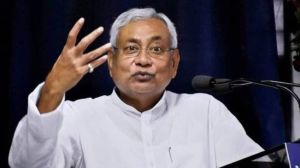Stay updated with the latest - Click here to follow us on Instagram
Climate and finance crises could leave 600 million hungry by 2030
The report pointed out that lack of improvement in food security and uneven access to healthy diets could lead to 582 million people being chronically undernourished by the end of the decade, more than half of them in Africa.
 Palestinian children gather to receive food cooked by a charity kitchen, amid food scarcity, as Israel-Hamas conflict continues, in the northern Gaza Strip (Reuters)
Palestinian children gather to receive food cooked by a charity kitchen, amid food scarcity, as Israel-Hamas conflict continues, in the northern Gaza Strip (Reuters)Climate-driven shocks, coupled with scant finance and government action, will leave nearly 600 million people living in hunger by 2030, the head of the United Nations International Fund for Agricultural Development (IFAD) told The Thomson Reuters Foundation in an interview.
Speaking ahead of Wednesday’s launch of IFAD’s report on the global state of hunger and nutrition, the agency’s president Alvaro Lario said that missing the UN’s Sustainable Development Goal of zero hunger by 2030 would lead to more forced migration, fewer new jobs and worsening conflict over resources, especially in regions with growing populations such as Africa.
More than a third of the world’s population – about 2.8 billion people – could not afford a healthy diet in 2022, the report said.
Of those people, more than 70% live in low-income countries.
The report pointed out that lack of improvement in food security and uneven access to healthy diets could lead to 582 million people being chronically undernourished by the end of the decade, more than half of them in Africa.
“Urgent steps are needed if we want to really bring down the numbers of almost 600 million of chronically undernourished people by 2030,” Lario said, adding, “the reality is we know how to do it, it’s just a matter of political will.”
Findings of the IFAD report will inform the agenda of the currently ongoing G20 ministers’ meeting in Brazil to discuss issues of hunger and poverty.
CLIMATE CHANGE A MAJOR FACTOR
The IFAD chief told The Thomson Reuters Foundation that floods, droughts and high temperatures driven by climate change are exacerbating hunger and malnutrition around the world.
He also blamed the lack of infrastructure to cope with climate shocks, debt-ridden economies and large gaps in climate finance for food production, storage and distribution.
This could hamper the UN’s new plan, presented at COP28 last year, to end hunger and malnutrition without breaching the Paris Agreement goal of limiting global warming to 1.5 degrees Celsius.
Food systems – including growing methods, fertilisers, storage, transportation and waste – account for nearly a third of greenhouse gas emissions worldwide.
At COP28 last year, the UN plan, for the first time, addressed emissions from how the world grows and consumes food.
This brought attention to the idea of a “just transition” in agriculture, and support for farmers in moving to more climate-friendly ways of growing food.
Small-scale producers feed more than 70% of the world’s population, but account for less than one-third of agricultural land and resources.
“Asking these hundreds of millions of small farmers who, in many cases, can barely make a living, to do a transition to certain agricultural practices, has a cost,” the IFAD president said.
He added that supporting these small-scale producers with loans, infrastructure and government policies that create good ecosystems “where they can thrive” is crucial.
However, Lario pointed out that the financing for food security and nutrition has not kept pace with the increasing need to tackle these challenges.
“People who live in the poor rural areas, the small-scale producers, are actually receiving less financing than before, compared to the overall climate finance flows,” Lario said.
Last year, research from the US-based Climate Policy Initiative looked at investments in climate adaptation linked to food security for small-scale farmers.
Lario highlighted that, according to the research, funding for these producers went from 1.7% of all global climate finance in 2018 to 0.8% in 2020.
Besides production, the IFAD president said that investment in distribution, storage, access to markets, and quality assurance is also urgently needed. “All these areas of the value chain can actually create a lot of jobs.”
But he noted that the funding gap is significantly large.
Citing a World Bank estimate, Lario said it would cost $350 billion to $400 billion a year to make global food systems more sustainable and inclusive.
“But if you look at why we need to fix it? We’re talking about around $6 trillion in terms of health costs because of obesity and malnutrition and $3 trillion in terms of climate and environmental costs of these systems,” he added.





- 01
- 02
- 03
- 04
- 05


























